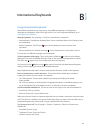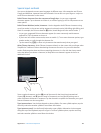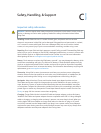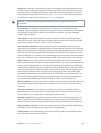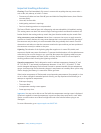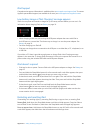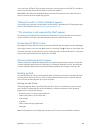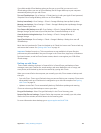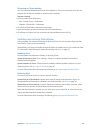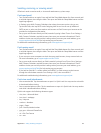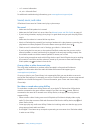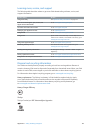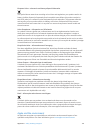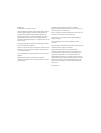Appendix C Safety, Handling, & Support 130
Removing an iTunes backup
You can remove an iPad backup from the list of backups in iTunes. You may want to do this, for
example, if a backup was created on someone else’s computer.
Remove a backup:
1 In iTunes, open iTunes Preferences.
•
Mac: Choose iTunes > Preferences.
•
Windows: Choose Edit > Preferences.
2 Click Devices (iPad doesn’t need to be connected).
3 Select the backup you want to remove, then click Delete Backup.
4 Click Delete to conrm you wish to remove the selected backup, then click OK.
Updating and restoring iPad software
You can update iPad software in Settings, or by using iTunes. You can also erase iPad, and then
use iCloud or iTunes to restore a backup.
Deleted data is no longer accessible through the iPad user interface, but it isn’t erased from iPad.
For information about erasing all content and settings, see Reset on page 117.
Updating iPad
You can update iPad software in Settings, or by using iTunes.
Update wirelessly on iPad: Go to Settings > General > Software Update. iPad checks for
available software updates.
Update software in iTunes: iTunes checks for available software updates each time you sync
iPad using iTunes. See Syncing with iTunes on page 16.
For more information about updating iPad software, go to support.apple.com/kb/HT4623.
Restoring iPad
You can use iCloud or iTunes to restore iPad from a backup.
Restore from an iCloud backup: Reset iPad to erase all settings and information. Sign in to
iCloud and choose Restore from a Backup in the Setup Assistant. See Reset on page 117.
Restore from an iTunes backup: Connect iPad to the computer you normally sync with, select
iPad in the iTunes window, and click Restore in the Summary pane.
When the iPad software is restored, you can either set it up as a new iPad, or restore your music,
videos, app data, and other content from a backup.
For more information about restoring iPad software, go to support.apple.com/kb/HT1414.



